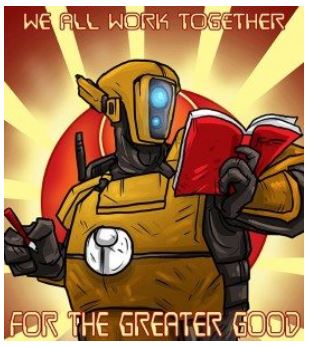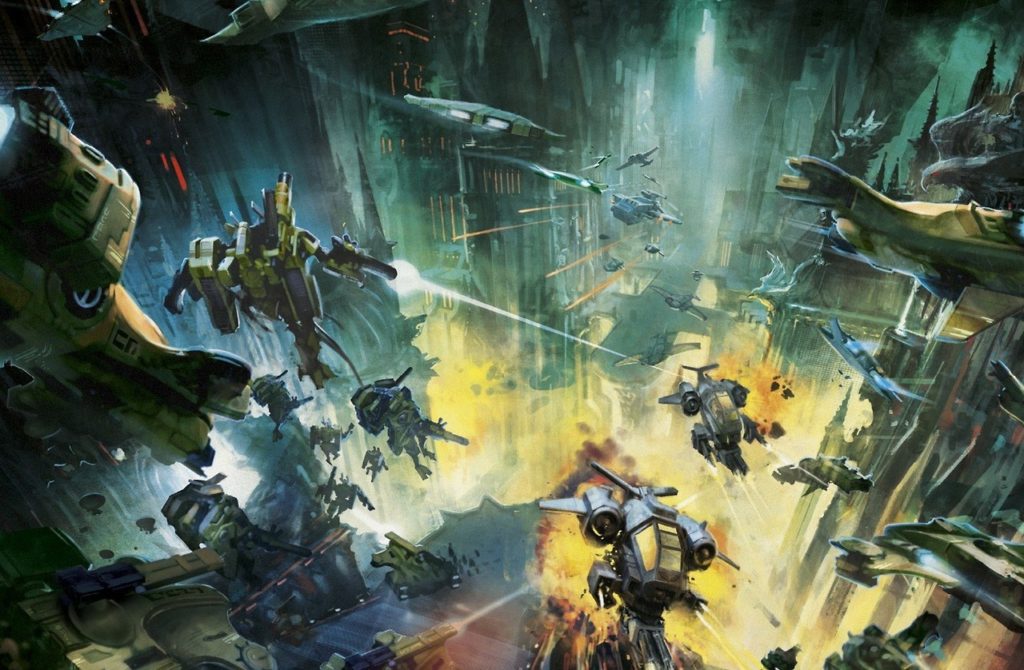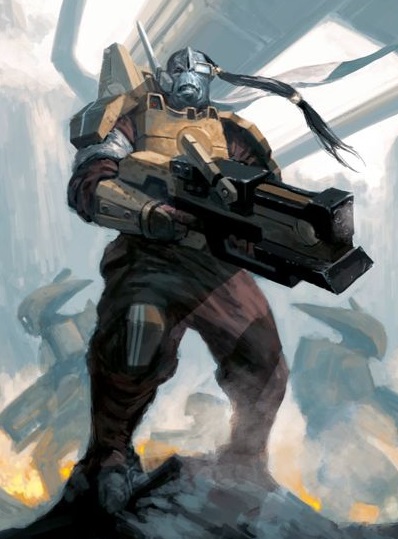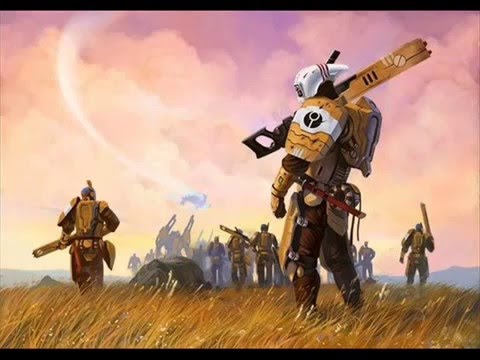
Hi folks! Rhys here with an analysis of Brian Pullen’s SoCal-winning T’au list.
Followers of competitive 40k will recall that a T’au player, Richard Siegler, won the Nova Open a few weeks back. And now we have another great player, another great T’au list, and another T’au win at a major 40k tournament: the SoCal Open.
The victorious player is Brian Pullen, a familiar name on the competitive 40k scene. At the time of writing, Pullen has a very respectable ITC ranking: ninth in the world.
Like Siegler a few weeks back, Pullen hits some of those standard T’au themes that have come to define T’au in eighth edition so far. But he adds some interesting spins to some of the classics.
First things first, let’s take a look at the list.
Pullen kicks things off with a T’au Sept outrider detachment, and immediately we can see how the Space Marine meta has influenced his choices. The Commander in this detachment is armed with three fusion blasters and a drone controller. We’ll discuss those choices in just a moment.
For this detachment’s obligatory trio of fast attack choices, Pullen takes three big units of Tactical Drones. Notice the composition of each unit: eight Shield Drones and three Marker Drones. Now the Commander’s choice of support system becomes clear: Pullen buffs his Marker Drones with his Commander’s drone controller, granting +1 BS if the Drone unit is within 6″ of the Commander.
Tactical Drones usually hit on 5s, making Marker Drones a somewhat unreliable source of much-needed markerlight tokens. But with his Commander buffing them, Pullen is looking at nine BS4 markerlights, averaging roughly four or five hits each turn. Moreover, these Drones will be tricky to remove: opponents will need to chew through eight Shield Drones in order to bring down a Marker Drone. Combined with the uplinked markerlight stratagem — after scoring one markerlight hit, immediately add an additional d3 — and the other markerlights scattered throughout his list, Pullen will be able to rely on a solid stack of markerlights throughout most of his turns.
Plenty of T’au lists in the current meta opt for lots of two-man Drone squads attached to a variety of units throughout the list — and Pullen’s list certainly does this to an extent. But savvy T’au players will know that medium-sized units of Drones do still have a place in the force. Indeed, Siegler used two units of six and one unit of five Shield Drones in his Nova list. And Pullen does a similar thing here. His units are slightly bigger, and he adds in some Marker Drones for variety, but the theme remains the same.

Let’s check out the next detachment in Pullen’s list: the obligatory T’au Sept trip-tide vanguard detachment.
And again we see the influence of the new Marines. For the HQ slot in this vanguard detachment, Pullen takes a Commander in a Coldstar Battlesuit armed with four fusion blasters. Indeed, Pullen runs two of his three Commanders in the Coldstar Battlesuit. These supercharged weapons of war give him incredible reach across the board: the Coldstar’s base movement is 20″, but it can also automatically advance up to 20″. Given that the range of the fusion blaster is 18″, this gives Pullen’s Coldstars an effective threat range of 58″.
But here’s the meat of the detachment: three Riptide Battlesuits. Each armed with a heavy burst cannon and smart missile systems, these units need no introduction, but I will briefly discuss the support systems that Pullen takes: each Riptide has an advanced targeting system, granting 1+ AP to each weapon, and a target lock, allowing the Riptide to move and shoot without penalty.
This means that Pullen opts against the velocity tracker, which would grant him 1+ to hit against units with the fly keyword. Again we see the footprints of the new meta: Marines have plenty of tools to deal with Aeldari flyers, so we now see far fewer Aeldari flyer spam lists. With fewer flyers in the meta, Pullen knows that he is less likely to need that 1+ against flyers, so he takes support systems that he knows will be useful regardless of the opponent.
Pullen’s final detachment is a T’au Sept battalion. In the troops slot, Pullen takes three squads of Fire Warriors, each with two Shield Drones and a Shas’ui armed with a markerlight. This setup has become a staple of modern T’au lists. The three small units of Fire Warriors cheaply fill out the obligatory troops requirement for the battalion, but the ever-useful markerlight and two Shield Drones add that extra layer of utility to what would otherwise be an underwhelming choice.
Moreover, we also find a Pathfinder team with a full complement of Drones: two Shield, one Pulse Accelerator, one Grav-Inhibitor, and one Recon. I spend some time on this unit in my previous article on Frontline Gaming, so here I’ll just say that this unit’s modest cost belies a surprising number of useful functions, and it’s no surprise that plenty of top-tier T’au lists opt to take it.

In the first of the two HQ slots, we find Pullen’s warlord, an Ethereal on a hover drone. Ethereals grant a very handy leadership bubble: T’au units within 6″ of an Ethereal may use its leadership instead of their own. This ability is strong for two reasons. First, it isn’t Sept-locked, meaning that all T’au units on the board regardless of Sept can take advantage of it. Second, Tactical Drones have a poor leadership characteristic, 6. This ability goes a long way to keep those large units of Drones from losing further models after they take casualties.
In the second HQ slot, we find Pullen’s third Commander, his second in the Coldstar Battlesuit. Again, this Commander is armed with four fusion blasters. We’ve yet to talk about the kind of damage output that Pullen can expect from these weapons. Let’s run some back-of-the-napkin numbers.
If we presume that the Commander runs four fusion blasters and the T’au player shoots at something with at least one markerlight token, he can all but guarantee all four shots hitting. But that was the easy bit.
Now comes the tricky part: we need to roll to wound. Let’s presume that we’re shooting at something big and scary, with a toughness of 8 and a save of at least 3+. The fusion blaster is strength 8, and, of course, strength 8 weapons wound toughness 8 targets on 4s, so this would yield two wounds on average.
Fusion blasters, like most melta weapons, have an AP of -4, which would drop a 2+ save down to a 6+ and would cut straight through a 3+ save. So we’re in for a pretty good chance of our two wounds converting to damage rolls.
Fusion blasters use the standard melta rules, so if the target is within 9″, the T’au player will be rolling two dice and picking the highest for each successful wound. The average roll on 2d6 is seven — a five and a two, a three and a four, and so on — so we could conservatively be looking at eight or nine points of damage. While most T’au Commanders aren’t going to be destroying Knights in one round of shooting, this is nonetheless respectable damage output.
If the target is outside of 9″, the T’au player will be rolling one dice for each successful wound. Two wounds would therefore average seven points of damage, as I mention above.
The fusion blaster is something of a tricky weapon for T’au Commanders. If you can isolate an enemy character, there’s a pretty strong chance of melting him down to molten slag, but that’s a tricky business. It involves a handful of different factors all going your way: simply being able to target the character for one, and if he has an invulnerable save, you could be in for a real pickle. It’s just not worth it a lot of the time. Especially since the T’au Commander is one of the few BS2 platforms in the army: they should be treated with due care and consideration.

And this brings me to the real issue I have with the fusion blaster: opportunity cost.
In my previous article, I talked about the idea of opportunity cost. Applied to 40k, it roughly means that the cost of taking one unit isn’t just the points cost; it’s also the units that you aren’t taking. And this idea is especially relevant when talking about the weapons loadout on a Commander. In order to take those fusion blasters, what aren’t you bringing? The answer is simple: cyclic ion blasters.
A T’au Commander armed with three cyclic ion blasters is a deadly foe, able to reliably damage almost anything in the game. Fusion blasters do have a place, but I would argue that in most scenarios, the T’au player would be better off with cyclic ion blasters.
But making changes like this is exactly what a significant shift in the meta should have us do. New codex books and new models should force us to reassess our own codex, our own models, in order to best deal with the new kid on the block. This is actually a pretty great thing. It shows Games Workshop is willing to make big changes to the meta of game — granted, they aren’t always going to get it right — in order to keep things fresh and exciting.
And Pullen’s list does exactly this. It takes what is best about the T’au, changes it as necessary, and wrecks face at one of the biggest 40k tournaments in the world.
And remember, Frontline Gaming sells gaming products at a discount, every day in their webcart!




Man I am so sick of riptide wing being the only way to go for tau
I agree. Tau could be so much better, but the reliance on (ie, necessity for) Riptides and Drones is stupid for both the player and the opponent.
The army might rank high on tournaments but only because of two broken units. Take them away and you’ve got an army that simply doesn’t function: they’re comparatively bad at everything in the game, even the bits where they need to shine (ie, shooting).
I don’t think GW knows what to do with the blue guys.
Tau have some other gems. I’ve been using stealth suits for a while with great success, they really are a spectacular unit! With the massive point drop they got from chapter approved, I expect to see a lot more of them. Especially with marine infiltration blocking Pathfinders ability to scout forward.
Another unit that might start seeing play post chapter approved is the ghostkeel. I could see dropping one riptide for two ghost kills being an option. Certainly something to experiment with!
I certainly hope so, I have a trio of ghostkeels I really want to make work.